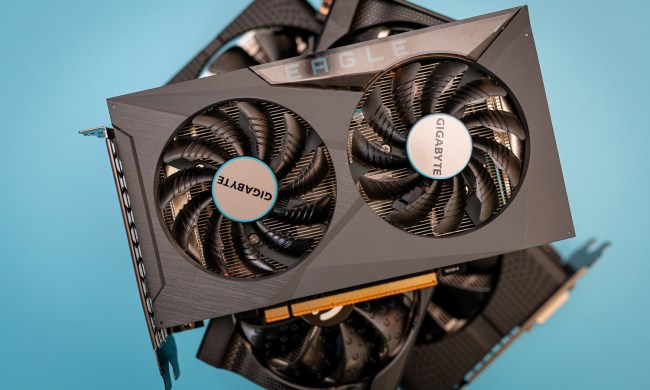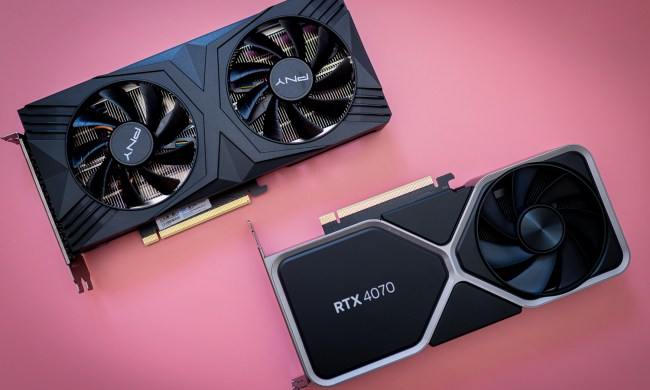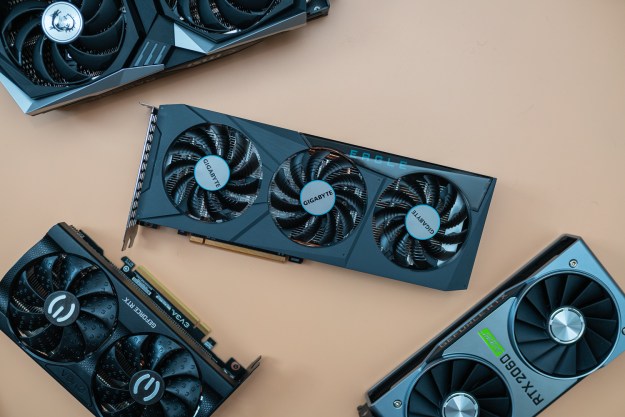
- Above 60 fps at 1080p in most games
- Single- to triple-fan design available
- Only 132 watts of total board power
- Hardware-accelerated ray tracing
- About 8% slower than the RTX 3060
- Doesn't have access to DLSS
- Poor ray tracing performance without upscaling
It’s unfortunate, but the GPU shortage has made it nearly impossible to shop for a good graphics card deal. Compared to the best graphics cards, AMD’s new RX 6600 isn’t stellar, and its list price just barely manages to be acceptable. But in a time when graphics card prices are dictated by shortages and scalpers, the RX 6600 could be the deal PC gamers are looking for.
It’s a petite card squarely targeting 1080p gamers, and based on my testing, it hits that mark well enough. The list price is higher than it should be, but the secondhand market generally prices Nvidia cards higher. You’ll likely be able to buy the RX 6600 for less than the Nvidia RTX 3060, which is the card AMD’s latest release directly competes with.
Once the dust has settled on the shortage, however, you could be left with a card that underperforms compared to the competition. And with features like better ray tracing and A.I.-assisted upscaling on Nvidia cards, the RX 6600 is a tough sell.
Design
Just like the RX 6600 XT, AMD isn’t releasing a reference model for the RX 6600. Instead, you’ll only be able to buy add-in board partner (AIB) models — and AIBs have spoiled us with options. From single-fan to triple-fan designs, there’s no shortage of cards to choose from.
AMD sent me the triple-fan Gigabyte Eagle, which looks and feels a lot more impressive than the RX 6600 has any right to. The shell is finished with a matte coating, and the card looked excellent displayed inside my Lian Li PC-011 Dynamic. Although one of the longer models available at 11 inches, the Eagle still adheres to the dual-slot design of the other AIB models.
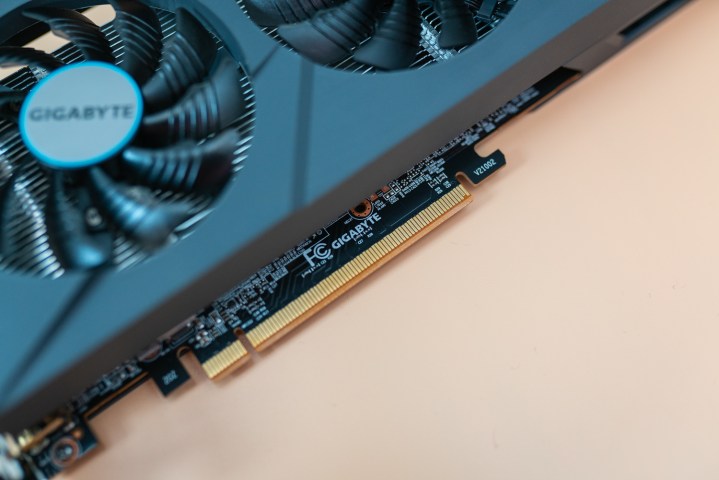
The three fans are just for aesthetic points, though. As I’ll dig into in the next section, the RX 6600 only has a board power of 132 watts, and it doesn’t get too hot under load. ASRock was able to squeeze the card into a single-fan design, and I don’t think it will struggle with heat too much. Still, you have plenty of options for AIB models, even if they’re more for looks than practical differences.
For ports, the Gigabyte Eagle comes with two DisplayPort 1.4a connections and two HDMI 2.1 connections. I would’ve preferred a third DisplayPort connection over the second HDMI — even with HDMI 2.1 increasing refresh rates, it makes sense to have three of one connection type for triple-monitor setups instead of splitting them. The RX 6600 is less than the price of a lot of monitors, though, so this is probably an edge case.
Looking through photos of launch models provided by AMD, I’m a fan of the Gigabyte Eagle and XFX Swift. For the most part, though, AIBs didn’t go crazy with their designs. The PowerColor Hellhound goes a little further with LED fans, but most manufacturers stuck with a traditional black, dual-fan design.
Specs
The RX 6600 is the weakest of AMD’s RDNA 2 lineup. It features 12% fewer compute units than the RX 6600 XT for a 13% drop in price, but otherwise the cards are very similar. They both come with 8GB of GDDR6 memory on a 128-bit bus, though the RX 6600 features lower clock speeds overall.
| Compute Units | Shading units | Game Speed | Boost speed | Memory capacity | TDP | Price | |
| Radeon RX 6600 | 28 | 1,792 | 2.04GHz | 2.49GHz | 8GB GDDR6 | 132W | $330 |
| Radeon RX 6600 XT | 32 | 2,048 | 2.35GHz | 2.59GHz | 8GB GDDR6 | 160W | $380 |
| Radeon RX 6700 XT | 40 | 2,560 | 2.32GHz | 2.58GHz | 12GB GDDR6 | 230w | $480 |
| Radeon RX 6800 | 60 | 3,840 | 1.82GHz | 2.11GHz | 16GB GDDR6 | 250w | $580 |
| Radeon RX 6800 XT | 72 | 4,608 | 2.02GHz | 2.25GHz | 16GB GDDR6 | 300W | $649 |
| Radeon RX 6900 XT | 80 | 5,120 | 2.01GHz | 2.25GHz | 16GB GDDR6 | 300W | $1,000 |
The RX 6600 should be about 15% below the XT model, but my testing shows a gap closer to 20%. That difference is likely on the back of clock speed, which will drop your frame rate. However, the lower speed helped AMD achieve a board power of only 132W, allowing you to use the RX 6600 with as little as a 450W power supply.
Nvidia only recommends a 450W power supply for the RTX 3060, and it has the same list price as the RX 6600. AMD is stressing its performance-per-watt advantage over the RTX 3060 here, with the RX 6600 offering up to a 1.5x boost to the metric over the RTX 3060. That doesn’t make a huge difference at these types of wattages, though, especially for a performant gaming PC.
AMD cards traditionally sell for less than Nvidia ones on the secondhand market, and the RX 6600 shouldn’t be any different.
Simply put, the RX 6600 is too expensive. It draws less power than the RTX 3060, sure, but it also isn’t as powerful. It’s a similar situation to the RX 6600 XT and RTX 3060 Ti. You’re paying around the same list price, but with a sizeable performance advantage in Nvidia’s corner.
As the GPU shortage has taught everyone, though, list price doesn’t mean anything. The good news is that AMD cards traditionally sell for less than Nvidia ones on the secondhand market, and the RX 6600 shouldn’t be any different. That pulls the favor back in AMD’s corner. The RX 6600 XT may not be as powerful as the RTX 3060 Ti, but it sells for almost $200 less on the secondhand market. I’d wager something similar will happen with the RX 6600 and RTX 3060 a few weeks after launch.
Gaming

The RX 6600 is tough to gauge. AMD has compared it to the RTX 3060, but the company also compared the RX 6600 XT to the RTX 3060. Based on my testing at 1080p, the RX 6600 actually sits below the RTX 3060, short of a powerful outing in Assassin’s Creed Valhalla. In reality, the RX 6600 is closer to the RTX 2060 Super.
You can see my results below. I ran tests from 1080p to 4K across Medium and Ultra presets, but the results below are for 1080p with Ultra settings. I ran all of my tests off of a Crucial MX500 2TB SSD inside a PC with an Intel Core i9-10900K and 32GB of RAM.
| AMD RX 6600 | AMD RX 6600 XT | Nvidia RTX 3060 | RTX 2060 Super | |
| 3DMark Time Spy (GPU score) | 8,071 | 9,644 | 8,629 | 8,513 |
| Red Dead Redemption 2 | 59 fps | 68 fps | 65 fps | 62 fps |
| Fortnite | 98 fps | 137 fps | 132 fps | 105 fps |
| Assassin’s Creed Valhalla | 71 fps | 83 fps | 64 fps | 66 fps |
| Battlefield V | 120 fps | 139 fps | 123 fps | 120 fps |
| Civilization VI | 138 fps | 161 fps | 143 fps | 150 fps |
The most straightforward fight is the DirectX 12-based 3DMark Time Spy, which showed some significant disparities for the RX 6600. The XT model is about 20% faster, while the RTX 3060 holds a solid 7% lead. Synthetic benchmarks aren’t games, but Time Spy shows the differences in cards clearly — and the RX 6600 is at the bottom of the pile.
That wasn’t true in all games, though. Assassin’s Creed Valhalla is one example where the RX 6600 showed about an 11% improvement over the RTX 3060. The XT model still led, but Valhalla seems to favor AMD cards more. Unfortunately, that wasn’t true in other titles. In Red Dead Redemption 2, for example, the RTX 3060 was about 10% faster than the RX 6600.
Taking the 1080p Ultra results together, the RTX 3060 is about 8% faster while the RX 6600 XT is about 21% faster. The RX 6600 is the same price (theoretically) as the RTX 3060, showing that AMD is pressing the advantage of the GPU shortage once again. To be clear, it’s a steal at $329 compared to what the RTX 3060 is selling for. And given what the RX 6600 XT is selling for, the non-XT model will likely go for less than the RTX 3060 on the secondhand market.
This is a card that squarely targets 1080p and manages to hit the mark.
Although I listed my 1080p Ultra results, optimizing a few settings can represent big increases in frame rate. The RX 6600 jumped to 83frames per second (fps) in Assassin’s Creed Valhalla with the High present, for example, and Battlefield V produced 158 fps with the Medium preset.
It shouldn’t come as a surprise that resolution is the killer, even if the RX 6600 can perform in some games at 1440p. It stilled managed 55 fps in Red Dead Redemption at 1440p, which is impressive considering how demanding that game is. In a less demanding title like Civilization VI, the RX 6600 was able to squeeze out above 100 fps, and it even managed to go above 60 fps at 4K.
Civilization VI was the only game I could manage at 4K, though. The card produced a pitiful 26 fps in Red Dead Redemption 2 and couldn’t crack the 30 fps mark in Fortnite. Without the help of FidelityFX Super Resolution (FSR), 4K is out of the question for the RX 6600. While 1440p is manageable, this is a card that squarely targets 1080p and manages to hit the mark.
Content creation

AMD cards generally underperform compared to Nvidia ones for content creation workloads — and the RX 6600 doesn’t change that. This is a 1080p gaming card, but my results (especially in Blender) show that you can use it for content creation, and sometimes even at an advantage over Nvidia.
| AMD RX 6600 | AMD RX 6600 XT | Nvidia RTX 3060 | RTX 2060 Super | |
| Blender BMW (seconds) | 86 | 79 | 45 | 58 |
| Blender Classroom (seconds) | 167 | 155 | 208 | 275 |
| Blender Koro (seconds) | 156 | 139 | 162 | 183 |
| PugetBench for Premiere Pro (overall score) | 605 | 625 | 703 | 784 |
In two out of the three Blender renders I tested, the RX 6600 managed to beat the RTX 3060 and RTX 2060 Super (though, those cards beat the RX 6600 in the BMW render by a significant margin). But we’re comparing apples to oranges here. Blender is able to utilize CUDA or OptiX for GPU rendering. AMD cards are restricted to OpenCL.
OptiX provides an unfair advantage for Nvidia. It’s just way faster than OpenCL, and even provides a significant advantage over CUDA rendering. Although my results favor the RX 6600, they don’t tell the full story. If Blender is an application you plan on using a lot, it’s best to stick with an Nvidia card.
PugetBench illustrates Nvidia’s lead in content creation more. Here, the RTX 3060 outperforms the RX 6600 by about 16%, factoring in the all of the components of the machine. The RX 6600 is capable of running these programs, but you’ll want to invest in a solid CPU and RAM kit to get the best performance.
Super Resolution and ray tracing
Like other RX 6000 cards, the RX 6600 comes with two excellent features — AMD Super Resolution and hardware-accelerated ray tracing. Just like its RDNA 2 siblings, though, the RX 6600 doesn’t handle ray tracing with grace. It comes down to a design difference between AMD and Nvidia cards that favors Team Green a lot more.
| AMD RX 6600 | AMD RX 6600 XT | Nvidia RTX 3060 | RTX 2060 Super | |
| Control no ray tracing | 67 fps | 73 fps | 76 fps | 75 fps |
| Control ray tracing | 27 fps | 34 fps | 47 fps | 41 fps |
| Cyberpunk 2077 no ray tracing | 46 fps | 62 fps | 59 fps | 55 fps |
| Cyberpunk 2077 ray tracing | 10 fps | 13 fps | 28 fps | 25 fps |
My average frame rate tanked by nearly 60% in Control and a massive 78% in Cyberpunk 2077 with ray tracing on. I ran all of these tests at 1080p with the highest-quality preset, controlling specifically for ray tracing. That means I didn’t use Nvidia Deep Learning Super Sampling (DLSS). The results above are pure ray tracing performance.
And AMD doesn’t look great. The RX 6600 has some big drops, which I expected. You can see from my RX 6600 XT results that this is a trend for AMD. That’s because Nvidia cards use a dedicated ray tracing processor, while AMD cards include an accelerator in each compute unit. My RTX 3060 and RTX 2060 Super results show how much a difference that design change makes.
Following in the footsteps of the RDNA 2 cards that came before, the RX 6600 doesn’t look strong here.
Regardless, none of the results above are playable with ray tracing on. You need an upscaling feature to take advantage of the demanding rendering. AMD offers Super Resolution, which can boost frame rates by a lot. Take the recent Back 4 Blood, which showcased up to a 116% increase in its aggressive Performance mode.
FSR can boost your frame rates, but it doesn’t look as good as the Nvidia-exclusive DLSS. In addition, FSR doesn’t always accompany ray tracing in games. Control and Cyberpunk 2077 are two prime examples. Both games support ray tracing and DLSS — which you usually find together — but neither supports FSR.
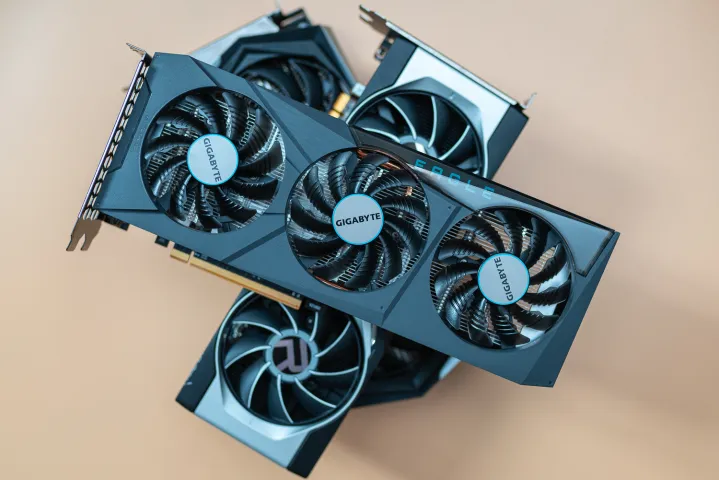
Super Resolution is a great feature, but it’s not a reason to buy the RX 6600. The feature is available on basically any graphics card. DLSS is a reason to buy an Nvidia card, though, as is the big boost in ray tracing performance.
Following in the footsteps of the RDNA 2 cards that came before, the RX 6600 doesn’t look strong here.
Our take
The AMD RX 6600 is as expensive as the RTX 3060 while not performing as well, and it lacks features like quality ray tracing and DLSS. The biggest factor in its favor is that AMD cards are selling for less than Nvidia ones on the secondhand market. It still manages smooth 1080p gaming in most games, even if it falls short of the Nvidia competition.
Right now, it’s a timing issue. If you need a graphics card, the RX 6600 will likely be one of the cheapest options from the past couple of generations. If you can snag one at launch, there’s no contest. But the RTX 3060 is faster, and even last-gen’s RTX 2060 Super has a leg up in some titles. That’s not to mention the RTX 3060 Ti, which is easily the best 1080p graphics card on the market.
I’m almost obligated to recommend the RX 6600 because there’s a chance you can pick one up at list price. That doesn’t mean it’s a great graphics card compared to the competition If market conditions were different, I can only wonder how AMD would price this card — and I doubt it would be $329.
Is there a better alternative?
Yes. The RTX 3060 is about 8% faster and has the same list price, and the RX 6600 XT is over 20% faster for only $50 more.
How long will it last?
The RX 6600 already struggles to maintain 60 fps in demanding titles like Red Dead Redemption 2 at 1080p. If you want to play the latest games with the settings turned up, the RX 6600 will start to feel underpowered within a couple of years. If you’re focused on esports and less demanding games, it will last for many years to come.
Should you buy it?
At list price, yes, but understand that you’re buying the second-best option. The RTX 3060 already isn’t a great graphics card considering its price, but it’s still faster than the RX 6600. In an ideal world, I’d recommend picking up an RTX 3060 Ti. But that’s not possible for most people considering how expensive they are on the secondhand market.




